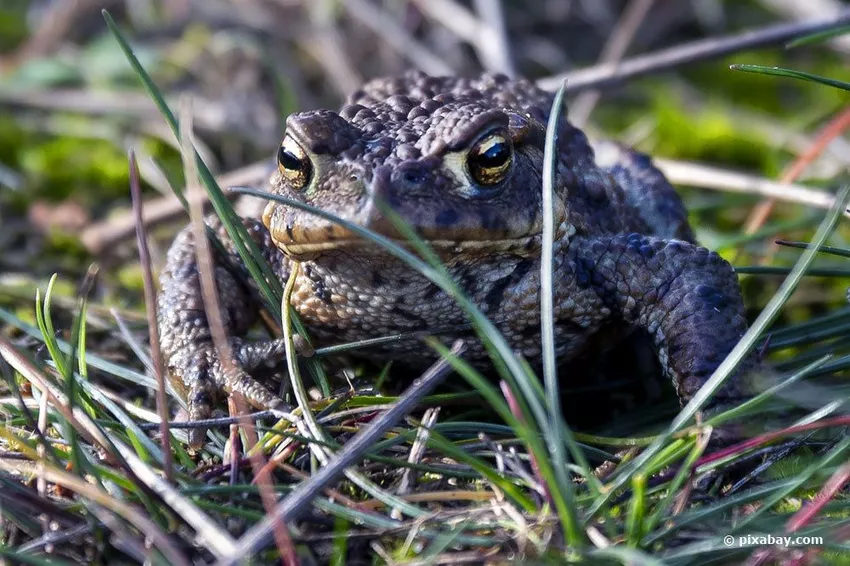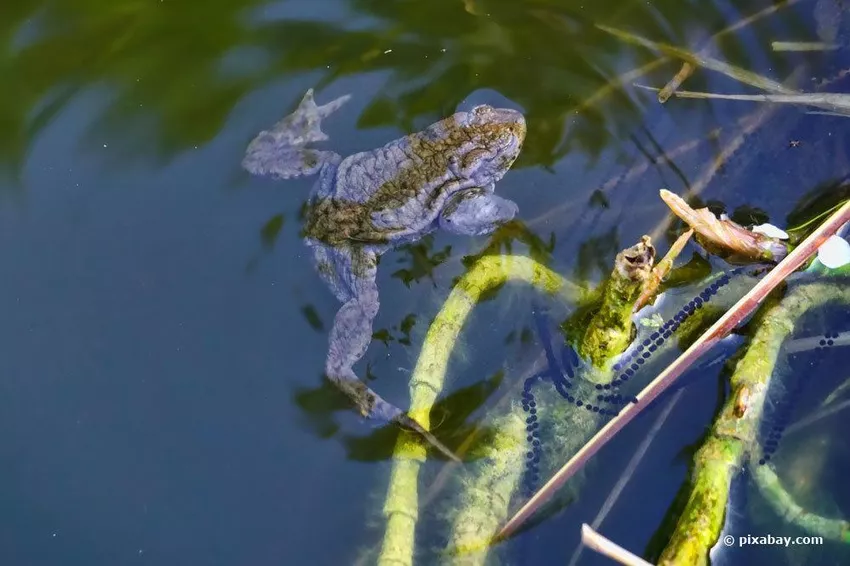
For some people, toads (Bufonidae) are just gross, while others are impressed and fascinated by these amphibians. If these animals then also settle down in the garden, good advice can sometimes be expensive. Should they simply be ignored or rather be expelled? However, the experienced hobby gardener appreciates the presence of the toads, as they can be useful helpers for him. He will do everything to make the animals feel at home.
Toads in the garden
Admittedly, toads don't look very pretty. Already in the Middle Ages they were considered the ugliest animal of all creation. As a rule, they are at home in forests and fields. However, they can also increasingly be found in gardens. The largest native toad species, the common toad (Bufo bufo), likes to settle here. It can grow up to 11 cm long, is brownish, gray or yellowish in color with a broad head and horizontally protruding pupils. The rather stocky body is covered with warty skin glands on the upper side, which secrete skin toxins to ward off enemies and protect against infections.
Due to their appearance and also their somewhat strange prophecies of doom, especially during the mating season, these toads are not welcome guests in all green oases. The question then often arises: expel or simply ignore? For experienced hobby gardeners, however, these animals are good friends and eager helpers in pest control. So they are beneficial and not a pest in the garden.

notice: The secreted skin toxin is not toxic to humans. However, you should always wash your hands after touching them.
Beneficial or pest?
Especially in healthy gardens, where no pesticides or other chemical agents are used, there can be an increased plague of pests. The voracious slugs are particularly feared by hobby gardeners. In a very short time, they can spread over several plots of land at the same time. In just one night, they wreak havoc by grazing large areas bare. The slugs can quickly become a plague. Since toads are nocturnal and so are slugs, the army of slugs can be decimated after a night of "work".
Those who have toads in their garden can now be happy, because they can help to get rid of the slugs in particular. But not only these pests can be fought with the help of nature, but are also on the menu of the amphibians
- mosquitoes and flies
- insect larvae and worms
- caterpillars and spiders
- Bugs, isopods and other beetles
Toads find a wide range of food, especially in gardens that are designed to be close to nature. For this reason, these animals should under no circumstances be driven away, because they are beneficial insects. They are completely harmless to humans and pets. They don't usually bother anyone with their presence. In other words, the more toads in the garden, the better for pest control.
notice: Amphibian habitats are gradually being destroyed, for example by draining wetlands, construction work or the application of pesticides. Because of this, they, including toads, are under one special protection. According to the Federal Nature Conservation Act and the Federal Species Protection Ordinance, they are allowed neither caught, injured nor destroyed will. Violations are punishable.
habitat of amphibians
In the wild, these animals live within a radius of one to two kilometers from their spawning grounds. They are very sedentary and therefore always return to this water during the mating season. If there is a near-natural pond in the garden area, it is quite possible that toads will also settle here. With a lot of luck they stay and hibernation is possible.
As already noted, the animals are nocturnal. During the day and when it is very hot, they take a break and hide in damp and dark places to avoid drying out, for example under stones, leaves, dead wood, under tree roots or in dug holes in the ground. They are only visible during the day when it is really raining.
Some support is needed to settle these helpers in your own garden when there is a snail plague. However, it should always be noted that the animals must not be caught in the wild. Only a suitable habitat can be created in the garden to enable the animals to resettle and stay voluntarily.
notice: The “greenhouse toads” are very popular. As the name suggests, they prefer to live in greenhouses. A bowl of milk used to be set up to attract visitors. So far, it has not really been possible to prove why milk is used.
Create living space in the garden
In any case, a near-natural garden pond with lots of vegetation would be ideal, since the animals spend part of their lives in the water and part on land. A body of water is particularly important during the mating season. The females lay their eggs on the plants in the water. From this small tadpoles develop and after some time a small toad. The good thing about a pond is that the following generations will lay their eggs here again and again. There would always be provision for offspring. However, there are a few things to keep in mind when creating a pond:
- Size between 5 and 10 m²
- Depth 1 to 1.5 m
- sunny to partially shaded place
- nutrient-poor non-acidic soil and water
- creation of floors
- good accessible flat spot from the outside
- then deeper water areas

It would of course be an advantage if there were no fish in the pond. These would eat the eggs and also small tadpoles as food. Amphibians also do not love excessive water movement. For this reason, complex fountains and other water features should be avoided. Only native plants are used for planting in the pond and in the surrounding area.
If possible, a small lawn should border the pond. The young toads can then leave the water unhindered after about six weeks. However, it would then be advisable not to mow the lawn for a few days to avoid injuries. If there is little space, the water point can be much smaller.
Not only would a pond be an advantage, the animals also need various hiding places.
shelter on land
Shelters on land are very important for the animals. Since they are only active during the night, they need retreats during the day to protect them from the sun and from enemies. Normally, toads use natural shelters such as mouse holes or mole burrows. Sometimes such hiding places are not always available, so shelters have to be created. There are different possibilities:
cairn
- partially shaded location
- many cavities between stones
- to do this, dig out 1 to 2 m² of soil to a depth of 20 to 30 cm
- filling with sand
- thereupon placement of stones
- Heap height between 1 and 1.5 m
- cover shady side with sand
Heaps of leaves, brushwood or dead wood
- Placement in secluded corners of the garden
- sunny to partially shaded place
- Diameter 1 to 2 m
- Height 1 to 1.5 m
- Renewal every few years
dry stone walls
Old walls are particularly popular with the animals. There are many cavities to hide here. In addition, heat is stored during the day, which is good for the cold-blooded animals.
hedges
Dense hedges are absolute oases for a toad. Here they usually find shelter from predators all year round. Native trees and shrubs should always be used for planting.
The animals also like to use corners of old sheds, greenhouses or compost heaps. If possible, a corner of the garden should always be left a bit wild and unmown. Other garden animals also benefit from this. A rich flora and be it just a flower meadow are necessary for the colonization of insects, then hedgehogs, birds and amphibians also come. A garden with a rich biodiversity is always a healthy garden.
frog house
Alternatively, a frog house can also be set up. These are commercially available, but you can also make them yourself from a clay flower pot. It is important that there is always a bowl of water available as a water source during dry periods if there is no pond. In addition, the property should not be completely closed off. There must be enough space for smaller animals to slip through the fence. This is also important for hedgehogs, for example. To ensure this, a "tunnel" can be built from a piece of pipe. So there is a stable passage for small animals.

notice: Just like the hedgehog or birds, a toad is not a pest but a beneficial creature in the garden. It is therefore absolutely necessary to refrain from expelling these animals.